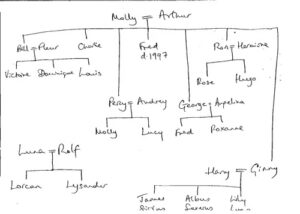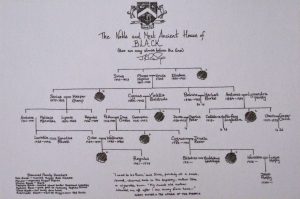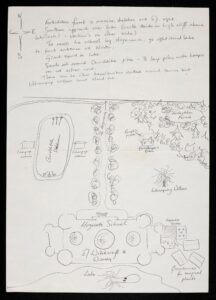This is a collection of facts that Rowling has revealed outside of the books, in various interviews and on her website over the years. For a collection of the information revealed on the Pottermore website, visit our Wizarding World Digital page.
Characters
Past (Adult Witches and Wizards)
- Arthur Weasley has two brothers.
- Molly Weasley’s maiden name is Prewett. Gideon and Fabian Prewett were indeed Molly’s brothers. Molly even gives Fabian’s watch to Harry for his 17th birthday. Their deaths do provide some explanation and excuse for some of Mrs. Weasley’s fears and her overprotective stance toward Harry.
- Sirius was “around twenty-two” years old when he was sent to Azkaban.
- When Aunt Petunia said Lily turned teacups into rats, she was exaggerating a little, although “just like her son, Lily was not averse to testing the limits of the Statute of Secrecy, so you can safely assume she will have had a few warning letters – nothing too serious, though.”
- James Potter was a Chaser on the Gryffindor Quidditch team (although the movie claimed he was a Seeker).
- James Potter inherited the Invisibility Cloak from his father.
- James Potter inherited lots of money and didn’t need a well-paying profession.
- Hagrid, Lily, and James were in Gryffindor.
- Hagrid could not produce a Patronus due to it being a difficult spell.
- For Hagrid, keeping dangerous creatures is all about overcoming something that could kill him.
- Over the course of the series, Dumbledore is 110–115 years old, McGonagall is 55–62 years old, and Snape is 31–39 years old.
- Voldemort may have reached a point of “inhumanity” where he did not need food.
- Nymphadora Tonks was in Hufflepuff.
- Moaning Myrtle was in Ravenclaw, and her full name is Myrtle Elizabeth Warren.
Present (Hogwarts Students)
- Fred and George's Patronuses are magpies.
- Fred and George Weasley were born on April Fools’ Day. Fred was born first.
- Dean Thomas’ father was killed by Death Eaters when he refused to join them. Neither Dean nor his mother knows.
- Ginny Weasley’s first name is Ginevra, and she is the first female Weasley born for “several generations.”
- Luna Lovegood was born on February 13.
- Neville Longbottom was born on July 30.
- Had Neville been targeted by Voldemort instead of Harry, he could have been killed. However, if Frank or Alice had sacrificed themselves for Neville like Lily did for Harry, it would have caused the Killing Curse to rebound just like it did with Harry, and Neville would have survived.
- Dumbledore does not think Neville would have had the qualities that enabled Harry to remain strong and sane throughout all of his many ordeals, believing that Voldemort did end up choosing the child most likely to be able to destroy him.
- Theodore Nott was raised by an elderly widower and a Death Eater father. He is a clever loner who does not need to join gangs, including Malfoy’s.
- Anthony Goldstein is Jewish and distantly related to Porpentina and Queenie Goldstein.
Future (Life After Hogwarts)
- In addition to their first child, Victoire, Bill and Fleur had two more children: Dominique and Louis.
- Charlie Weasley never married or had children.
- Percy Weasley married a woman named Audrey and had two children: Molly and Lucy.
- George Weasley married Angelina Johnson and had two children: Fred and Roxanne.
- Draco Malfoy married a woman named Astoria Greengrass.
- Scorpius Malfoy's middle name is Hyperion.
- Harry and Ginny's children James and Lily were given the middle names of Sirius and Luna, respectively.
- JKR sees Neville and Luna as very different people. She says that, although they share a certain isolation within the walls of Hogwarts, this wasn’t enough to foster true love. They may be friends, but “Neville would always find Luna’s wilder flights of fancy alarming.”
- Luna Lovegood married Rolf Scamander (grandson of Newt Scamander), and they had two children: Lorcan and Lysander.
Family Trees
Weasley Family Tree

Black Family Tree

Hogwarts
Items and Locations
- The gems in the Hufflepuff hourglass are diamonds.
- The Hufflepuff common room is in the same corridor as the Hogwarts kitchens and is accessed through a stack of barrels on the right-hand side of the corridor. The barrel in the middle of the second row conceals the entrance, and to enter one must tap the rhythm of “Helga Hufflepuff” on the barrel. The Hufflepuff common room is also the only one with a built-in defense system. Anyone who taps the wrong rhythm or the wrong barrel is immediately doused in vinegar.
- The Hufflepuff common room has not been entered by outsiders for over a thousand years and is the only common room that Harry Potter does not visit in any of the seven books.
- Although many of Salazar Slytherin’s direct descendants knew about and even entered the Chamber of Secrets during their time at Hogwarts, Tom Riddle was the first and only person to use the Basilisk to attack Muggle-borns.
School Operations
- Muggle education is not required for wizard children prior to attending Hogwarts.
- A magical quill detects the birth of every magical child and records it in a book, and Professor McGonagall sends an owl to each child when he or she turns 11.
- Most wizard children are home educated before Hogwarts because they cannot be trusted to keep their magical abilities hidden from Muggle schoolmates.
- There is no tuition fee at Hogwarts; the Ministry of Magic covers the cost of all magical education.
- Dumbledore did not request the school song since Book 1 because he has not felt as “buoyant;” times were getting darker.
Teachers and Students
- The Hogwarts teachers do not stay at Hogwarts during the Christmas holidays. However, Filch, Hagrid, and Dumbledore do.
- A few of the Hogwarts professors have spouses.
- Hogwarts has about a thousand students.
- If a teacher is head of a Hogwarts House, they were in that House; that goes for ghosts as well.
- Prefects can take House points, although Ron contradicts this when he becomes a prefect himself in Order of the Phoenix.
School Grounds
Sketch of Hogwarts

Wizarding World
Community
- The approximate value of a Galleon is about £5 ($7.30 or €8.00), though the exchange rate varies.
- The Gringotts goblins return the Muggle money they acquire back into circulation.
- Azkaban is in a sea north of the North Sea, a very cold sea.
- None of the pure-blood families are actually “pure” – they merely cross Muggles and Squibs off the family tree. The number of families who can claim to be pure is diminishing since they are finding it increasingly difficult to perpetuate themselves.
- Witches and wizards have longer lifespans than Muggles.
- Before the Hogwarts Express, students used Portkeys to get to school (with limited success). It was Ottaline Gambol (Minister of Magic 1827–1835) who decided to use a magically modified Muggle train to transport students to Hogwarts. Obtaining the Hogwarts Express involved 167 Memory Charms and the largest ever mass Concealment Charm performed in Britain. Evangeline Orpington (Minister of Magic 1849–1855) came up with the idea of adding a concealed platform, which would only be accessible to witches and wizards, to the (then) new King’s Cross station.
- Platform Nine and Three-Quarters isn’t the only fractional platform at King’s Cross station. Platform seven-and-a-half will take you to wizard-only villages throughout Europe, for example, while other platforms may be opened temporarily for transportation to large events.
Magic and Spells
- Muggles would not be able to brew potions because magic is always required at some point in the process.
- You can do unfocused and uncontrolled magic without a wand (like when Harry blows up Aunt Marge), but to perform really good spells, you need a wand.
- The animal an Animagus turns into is a reflection of his/her personality.
- Veritaserum is not used in criminal trials because it works best on “the unsuspecting, the vulnerable, and those insufficiently skilled (in one way or another) to protect themselves against it.” Veritaserum is not infallible.
- Wizards can make themselves untraceable, which is why they can’t be found simply by sending and following owls.
- When using a Fidelius Charm, not even the subjects of the secret themselves can divulge the secret.
- A witch or wizard's Patronus may change over their lifetime. Instances known to have altered the form on a Patronus include falling in love, mourning, and extreme shifts in a person's values.
- Albus Dumbledore invented communicating with other wizards through the use of a Patronus and taught this to the members of the Order of the Phoenix. They are the only wizards who know how to use this form of sending messages.
- To remove the tail that Hagrid gave Dudley in the hut on the rock, the Dursleys went to a private hospital where the staff were very discreet and said that a wart had gone out of control.
Magical Artifacts
- Fred and George never noticed Pettigrew on the Marauder’s Map because they didn’t know who he was. Even if they had recognized his name, they would have assumed he was just a student with the same last name. Pettigrew was one of many moving dots on the map, and Fred and George would have only been focused on the path their mischief took that day.
- When the Marauder’s Map insulted Snape, Prongs was not writing the insult, but it was like he had left a magical recording of his voice in the map.
- Colin Creevey’s Muggle camera worked because it was “running off the magical atmosphere,” and his photographs were developed “in the magical potion that causes the figures therein to move.”
- Arthur Weasley's flying Ford Anglia that Harry and Ron take to Hogwarts remained in the Forbidden Forest.
Magical Beings and Creatures
- Mrs. Norris is not an unregistered Animagus, but an intelligent (and unpleasant) cat.
- Dragons can’t be domesticated, no matter what Hagrid thinks.
- Crookshanks is half Kneazle.
- A group of Puffskeins or Pygmy Puffs is called a poffle.
- The skeleton of a five-legged creature that Harry finds in the Room of Requirement while searching for a place to hide the Half-Blood Prince's copy of Advanced Potion-Making is that of a Quintaped.
- House-elves are different from wizards; they have their own brand of magic, and the ability to appear and disappear within the castle is necessary to them if they are to go about their work unseen, as house-elves traditionally do.
- Shortly after Hagrid released Fluffy into the Forbidden Forest, Dumbledore arranged for the three-headed dog to be sent back to his native Greece.
- Kreacher the house-elf died at the age of 666.
- Peeves the Poltergeist is not a ghost, nor was he ever a living person; he is an “indestructible spirit of chaos."
- The happiest people do not become ghosts.
Wizards of the Month
J.K. Rowling began offering a "Wizard of the Month" section on her website in May 2004 beginning with Cheering Charm inventor Felix Summerbee. Rowling stopped releasing new entries in October 2007, ending with Harry Potter himself. Each of the original entries has been brought here straight from Rowling's website for your reading pleasure.
2007
- October – Harry Potter (1980–present): The Boy Who Lived, only known survivor of the Avada Kedavra curse and conqueror of Lord Voldemort, also known as Tom Riddle. Harry Potter joined the reshuffled Auror Department under Kingsley Shacklebolt at age 17, rising to become Head of said department in 2007.
- September – Albus Dumbledore (1881–1996): Brilliant and often controversial Headmaster of Hogwarts School of Witchcraft and Wizardry, Albus Dumbledore is most famous for his 1945 defeat of Grindelwald and his steadfast championing of Harry Potter, the Boy Who Lived. Dumbledore's self-proclaimed proudest achievement, however, was featuring on a Famous Wizards Chocolate Frog Card.
- August – Rowena Ravenclaw (Medieval, precise dates unknown): One of the four famous founders of Hogwarts School of Witchcraft and Wizardry, Rowena Ravenclaw was the most brilliant witch of her time, though legend has it that a broken heart - cause unknown - contributed to her early demise.
- July – Godric Gryffindor (Medieval, precise dates unknown): One of the four famous founders of Hogwarts School of Witchcraft and Wizardry, Godric Gryffindor was the most accomplished dueller of his time, an enlightened fighter against Muggle discrimination and the first owner of the celebrated Sorting Hat.
- June – Salazar Slytherin (Medieval, precise dates unknown): One of the four celebrated founders of Hogwarts School of Witchcraft and Wizardry, Salazar Slytherin was one of the first recorded Parselmouths, an accomplished Legilimens, and a notorious champion of pureblood supremacy.
- May – Helga Hufflepuff (Medieval, precise dates unknown): One of the four celebrated founders of Hogwarts, Hufflepuff was particularly famous for her dexterity at food-related charms. Many recipes traditionally served at Hogwarts feasts originated with Hufflepuff.
- April – Magenta Comstock (1895–1991): Experimental artist whose portraits' eyes not only follow the viewer around the room but also follow them home.
- March – Tilden Toots (1959–present): 'The wizard with three green thumbs'. Celebrity herbologist and radio personality.
- February – Mnemone Radford (1562–1649): Developed Memory Modifying Charms. First Ministry of Magic Obliviator.
- January – Harvey Ridgebit (1881–1973): Dragonologist, caught first Peruvian Vipertooth, established world's largest dragon sanctuary in Romania.
⬆ Back to Wizards of the Month
2006
- December – Laurentia Fletwock (1947–present): Celebrated breeder and racer of winged horses. Has campaigned for tighter restrictions on broomstick use.
- November – Lorcan d'Eath (1964–present): Heartthrob singer, part vampire, nineteen weeks at number 1 with hit song 'Necks to You'.
- October – Idris Oakby (1872–1985): Founder of the S.S.S. (Society for the Support of Squibs).
- September – Hambledon Quince (1936–present): Developed a theory that wizards originate from Mars, Muggles from mushrooms.
- August – Erica Stainwright (1932–2001): Disgraced 1950s housekeeping guru who made a fortune selling 'cleaning' potions that created more mould and grime.
- July – Tarquin McTavish (1955–present): Imprisoned for crimes against Muggle neighbour, who was discovered trapped inside McTavish's kettle.
- June – Daisy Hookum (1962–present): Wrote bestseller 'My Life as a Muggle' after giving up magic for a year. Married to celebrity gardener Tilden Toots.
- May – Fabius Watkins (1940–1975): Legendary Captain and Chaser of Montrose Magpies. Died in freak collision with helicopter.
- April – Grogan Stump (1770–1884): Popular Minister for Magic, appointed 1811.
- March – Daisy Dodderidge (1467–1555): First landlady of the Leaky Cauldron.
- February – Yardley Platt (1446–1557): Serial goblin-killer.
- January – Jocunda Sykes (1915–present): Famous for flying across the Atlantic on a broomstick - the first person to do so.
⬆ Back to Wizards of the Month
2005
- December – Bowman Wright (1492–1560): Famous for developing the Golden Snitch.
- November – Carlotta Pinkstone (1922–present): Famous campaigner for lifting the International Confederation of Wizard's Statute of Secrecy and telling Muggles that wizards still exist. Ms. Pinkstone has been imprisoned several times for her blatant and deliberate use of magic in public places.
- October – Fifi LaFolle (1888–1971): Author of the 'Enchanted Encounters' series.
- September – Gaspard Shingleton (1959–present): Celebrated inventor of the Self-Stirring Cauldron.
- August – Bridget Wenlock (1212–1285): Famous Arithmancer. First to establish the magical properties of the number seven.
- July – Chauncey Oldridge (1342–1379): First known victim of Dragon Pox.
- June – Elfrida Clagg (1612–1687): Chieftainess of Warlock's Council.
- May – Felix Summerbee (1447–1508): Inventor of Cheering Charms.
- April – Gondoline Oliphant (1720–1799): Famous for studies of life and habits of trolls. Clubbed to death in the Cotswolds while sketching.
- March – Mungo Bonham (1560–1659): Famous wizard healer. Founded St. Mungo's Hospital for Magical Maladies and Injuries.
- February – Artemisia Lufkin (1754–1825): First witch to become Minister for Magic.
- January – Derwent Shimpling (1912–present): Ate an entire Venomous Tentacula for a bet and survived, though is still purple.
⬆ Back to Wizards of the Month
2004
- December – Ignatia Wildsmith (1227–1312): The witch who invented Floo powder.
- November – Devlin Whitehorn (1945–present): Founder of the Nimbus racing broom company.
- October – Glenda Chittock (1964–present): Popular presenter of the W.W.N. (Wizarding Wireless Network) programme 'Witching Hour'.
- September – Uric the Oddball (Medieval, dates unknown): Highly eccentric wizard who is famed, among other things, for wearing a jellyfish for a hat.
- August – Honoria Nutcombe (1665–1743): Founded the Society for the Reformation of Hags.
- July – Donaghan Tremlett (1972–present): Bass player with the popular wizarding band The Weird Sisters.
- June – Gwenog Jones (1968–present): Captain and Beater of the only all-female national Quidditch Team, the Holyhead Harpies.
- May – Felix Summerbee (1447–1508): Inventor of Cheering Charms.

